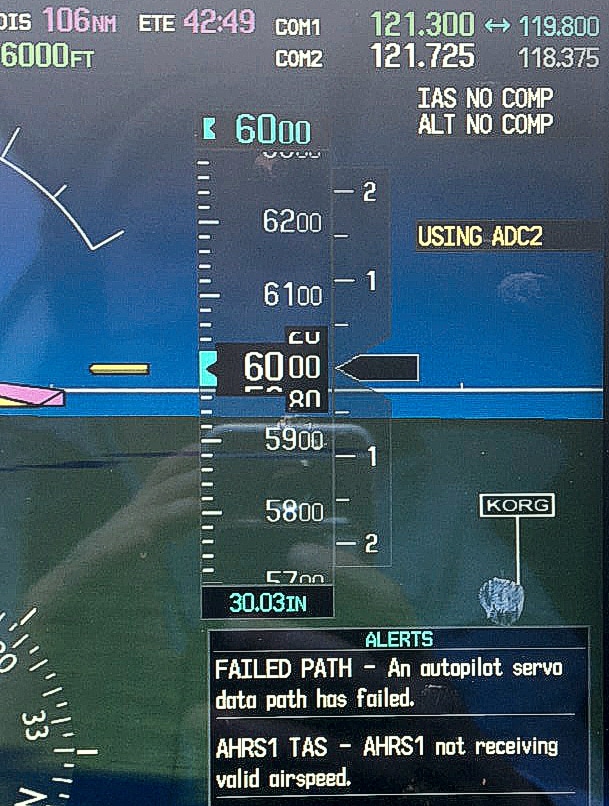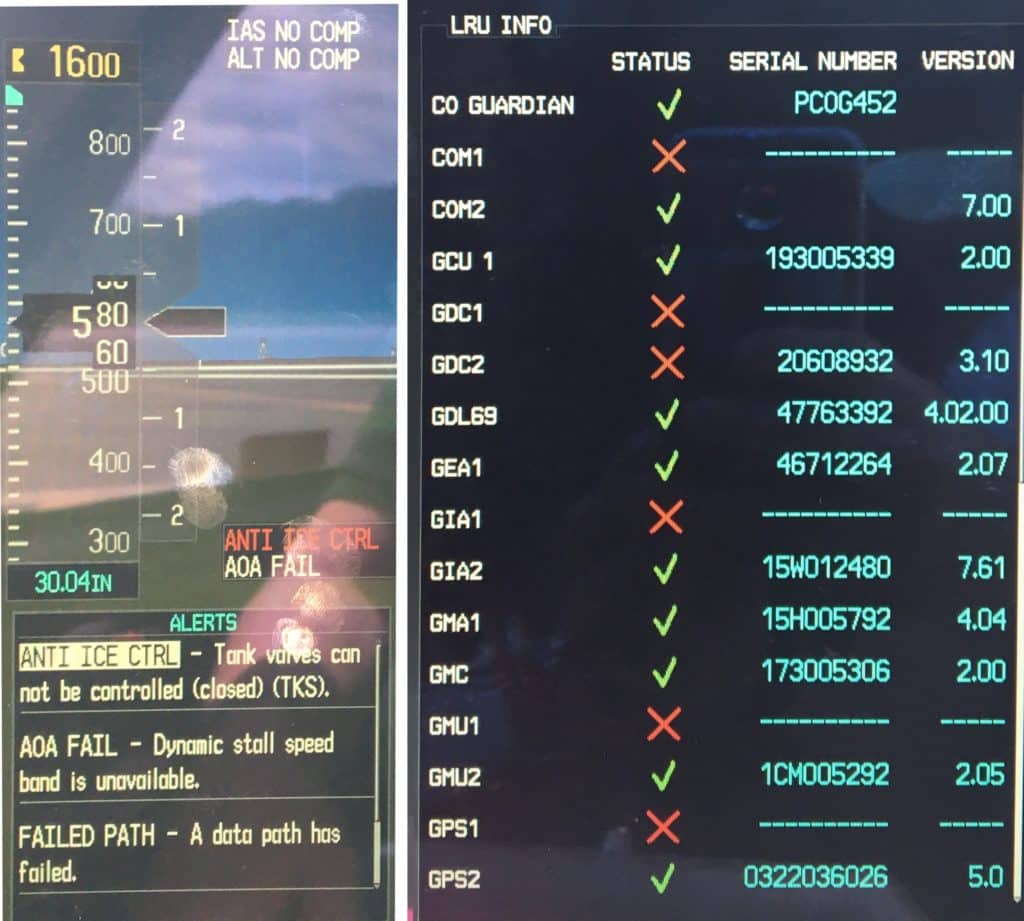
Kim is a successful engineer based in Silicon Valley, California, who had just purchased a Florida-based 2010 Cirrus SR22T. Kim arranged to have a professional ferry pilot fly the plane from Florida to San Antonio, Texas, where she planned to go through Cirrus transition training before flying the plane to its new West Coast home.
Donna, the ferry pilot, picked up the airplane in Punta Gorda, Florida (KPGD) and made a fuel stop at Stennis International Airport (KHSA) in Bay St. Louis, Mississippi just northeast of New Orleans. The flight took 3+55 and went smoothly and squawk-free. After refueling, Donna launched for the intended destination, Stinson Municipal Airport (KSSF) in San Antonio, 473 nm to the west. With a TAS of 165 knots and a 10-knot headwind, this final leg was expected to take about 3+15.
The flight didn’t go as planned. As the aircraft was passing Beaumont, Texas at 6,000 feet about 1+45 into the flight, the autopilot unexpectedly disconnected and the Primary Flight Display (PFD) of the Cirrus’ Garmin Perspective glass cockpit (essentially a G1000 on steroids) started displaying a series of error messages:
- USING ADC2
- IAS NO COMP
- ALT NO COMP
- FAILED PATH – An autopilot servo data path has failed
- AHRS1 TAS – AHRS1 not receiving valid airspeed
Donna decided it would be unwise to press on to San Antonio, and made a precautionary landing at Sugar Land Regional Airport (KSGR) on the southwest side of Houston. She taxied to the Cirrus Authorized Service Center on the field, Houston Aviation Center, and had a brief conversation with one of the technicians there. The technician referred her to the avionics shop next door, Sugar Land Avionics. The avionics shop owner, Bob Tyler, came over to chat with Donna. Shortly thereafter, Donna taxied the airplane to Bob’s shop. She then called Kim, the aircraft owner, to let her know where her airplane was stuck AOG and why.
Team Effort
Before purchasing the Cirrus, Kim had engaged Savvy Aviation to manage the prebuy for her in Florida. As soon as she took title to the plane, she enrolled it in Savvy’s concierge maintenance management service (SavvyMx). So, she opened an AOG ticket on Savvy’s online system describing the situation as Donna had explained it to her, and attaching the photo of the PFD error messages that Donna had sent her.
Al Hawthorne A&P/IA was Kim’s primary Savvy account manager, and Tony Barrell A&P/IA was her backup account manager and the on-duty manager for breakdown assistance. Tony responded to Kim’s ticket posts within one minute after she posted the description of her predicament and the PFD photo. He phoned Donna for a detailed debriefing on the situation, then notified Al. Tony and Al quickly decided to get Savvy’s avionics guru Mark Colman involved. Mark phoned Bob Tyler at Sugar Land Avionics. Now there were four experts on the case: two veteran A&P/IAs (Tony and Al) and two veteran avionics technicians (Bob and Mark).
Initial troubleshooting indicated that the #1 air data computer (ADC-1) status was intermittently changing from green to red and back to green during power-up, and that if it was red during the autopilot preflight self-test, the autopilot would refuse to come online. Bob (the avionics shop owner) initially quoted $1,000 for an overhauled replacement ADC that would take two days to arrive, plus four hours of labor to reload the system software.
Mark felt that before replacing ADC-1, it would make sense to swap ADC-1 with ADC-2 to see what happens. Meantime, Al said he’d seen failures of the sort that Donna reported caused by a bad sealed aircraft battery, and suggested that a capacity check be performed on the ship’s battery to rule this in or out.
Bob performed a battery “cap check” that revealed that the aircraft’s Concorde sealed battery was at 102% of rated capacity, thereby ruling this out as a possible cause. Bob tried reloading the software for ADC-1 but the symptoms remained unchanged. He then swapped ADC-1 and ADC-2 per Mark’s suggestion and the system booted up and performed normally with no error messages.
Is Anybody Goin’ to San Antone?
The aircraft was released to Donna with ADC-1 and ADC-2 swapped. She flew the plane from Sugar Land Regional (KSGR) to Stinson Municipal (KSSF). At first, everything seemed to be working perfectly. However, midway through the one-hour flight, the balky ADC (now in the ADC-2 position) went tango uniform.

The autopilot continued to function (since it uses ADC-1), but an ADC-2 warning appeared on the PFD. When Donna switched the PFD from ADC-1 to ADC-2, the airspeed, altitude and vertical speed “tapes” became X’d out. Bottom line was that the airplane was fully flyable but without the intended redundancy of having dual ADCs.
Meantime, Kim had taken an airline flight to San Antonio and was anxious to begin her Cirrus transition training with Donna. They decided that they would live with the bad ADC-2 until the transition training was completed, and then bring the plane back to Sugar Land to have the ADC replaced before Kim flew the plane home to California.
Mark contacted Bob Tyler at Sugar Land Avionics and asked him to arrange an advanced exchange GDC-74A to be shipped ASAP so it would be ready to install in Kim’s airplane as soon as she and Donna were done with transition training. (An “advanced exchange” is when the manufacturer ships an exchange unit first and receives the faulty one back afterwards.)
Cascading Failures of Multiple Systems
That plan seemed like a good one, but it unravelled two days later. Kim and Donna had done a training flight in the morning. When they first powered up the airplane, the avionics fan did not seem to come on, but it came on a bit later so they weren’t particularly concerned and continued the training. Then on final approach to KSSF, tons of stuff started failing and the PFD lit up like a Christmas tree with error messages. They landed and phoned Mark, who characterized what they reported as “cascading failures of multiple systems.”

Mark had the feeling that this must be power-related, so he had Kim and Donna pull and reset all the avionics circuit breakers but it didn’t help. Kim uploaded the data from her Garmin MFD SD card to the SavvyAnalysis platform, where Savvy’s chief analyst Joe Godfrey looked at it and saw evidence of power glitches and low bus voltages. The local FBO at KSSF was asked to hook the plane up to their 28-volt ground power unit (GPU) and all the avionics seemed to power up fine on GPU power, except for the balky ADC-2. This seemed to confirm that there were two problems, a power-related issue and a bad ADC-2 (which used to be ADC-1).
The next morning, Kim was able to arrange to have a local A&P at KSSF clean and reseat all the power connectors. After that, everything seemed to work fine except for ADC-2. So Kim and Donna were able to complete their training, and then flew to KSGR where Bob Tyler had received the advance exchange GDC-74A ready to install. That cured the ADC-2 issue.
The next morning, Kim finally launched out of KSGR headed home to California. She stopped for fuel in Hobbs, New Mexico and posted to the ticket from her smartphone to let the Savvy team know that all the avionics were performing flawlessly.
Kim’s decision to enroll the new-to-her Cirrus SR22T in Savvy’s flagship SavvyMx maintenance management program gave her instant access to the technical expertise she needed when all hell broke loose with her advanced Garmin Perspective avionics suite halfway across the country. Two of Savvy’s most experienced Cirrus experts plus our top avionics expert and our chief data analysis all worked with Kim, her instructor Donna, and three different shops at two different airports to get her problems resolved so she could complete her transition training and fly her plane back home to California with minimum delay.
Wouldn’t YOU feel more confident with Savvy’s technical team on your side? Click to learn more about SavvyMx.
You bought a plane to fly it, not stress over maintenance.
At Savvy Aviation, we believe you shouldn’t have to navigate the complexities of aircraft maintenance alone. And you definitely shouldn’t be surprised when your shop’s invoice arrives.
Savvy Aviation isn’t a maintenance shop – we empower you with the knowledge and expert consultation you need to be in control of your own maintenance events – so your shop takes directives (not gives them). Whatever your maintenance needs, Savvy has a perfect plan for you: